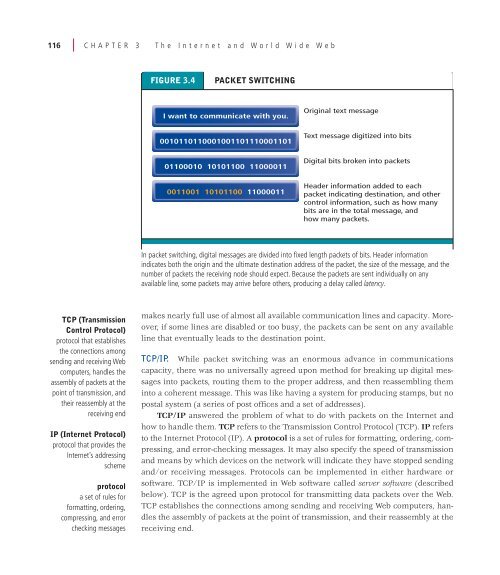The Internet and World Wide Web: E-commerce Infrastructure
The Internet and World Wide Web: E-commerce Infrastructure
The Internet and World Wide Web: E-commerce Infrastructure
You also want an ePaper? Increase the reach of your titles
YUMPU automatically turns print PDFs into web optimized ePapers that Google loves.
116 CHAPTER 3 <strong>The</strong> <strong>Internet</strong> <strong>and</strong> <strong>World</strong> <strong>Wide</strong> <strong>Web</strong><br />
FIGURE 3.4<br />
PACKET SWITCHING<br />
I want to communicate with you.<br />
0010110110001001101110001101<br />
01100010 10101100 11000011<br />
Original text message<br />
Text message digitized into bits<br />
Digital bits broken into packets<br />
0011001 10101100 11000011<br />
Header information added to each<br />
packet indicating destination, <strong>and</strong> other<br />
control information, such as how many<br />
bits are in the total message, <strong>and</strong><br />
how many packets.<br />
In packet switching, digital messages are divided into fixed length packets of bits. Header information<br />
indicates both the origin <strong>and</strong> the ultimate destination address of the packet, the size of the message, <strong>and</strong> the<br />
number of packets the receiving node should expect. Because the packets are sent individually on any<br />
available line, some packets may arrive before others, producing a delay called latency.<br />
TCP (Transmission<br />
Control Protocol)<br />
protocol that establishes<br />
the connections among<br />
sending <strong>and</strong> receiving <strong>Web</strong><br />
computers, h<strong>and</strong>les the<br />
assembly of packets at the<br />
point of transmission, <strong>and</strong><br />
their reassembly at the<br />
receiving end<br />
IP (<strong>Internet</strong> Protocol)<br />
protocol that provides the<br />
<strong>Internet</strong>’s addressing<br />
scheme<br />
protocol<br />
a set of rules for<br />
formatting, ordering,<br />
compressing, <strong>and</strong> error<br />
checking messages<br />
makes nearly full use of almost all available communication lines <strong>and</strong> capacity. Moreover,<br />
if some lines are disabled or too busy, the packets can be sent on any available<br />
line that eventually leads to the destination point.<br />
TCP/IP. While packet switching was an enormous advance in communications<br />
capacity, there was no universally agreed upon method for breaking up digital messages<br />
into packets, routing them to the proper address, <strong>and</strong> then reassembling them<br />
into a coherent message. This was like having a system for producing stamps, but no<br />
postal system (a series of post offices <strong>and</strong> a set of addresses).<br />
TCP/IP answered the problem of what to do with packets on the <strong>Internet</strong> <strong>and</strong><br />
how to h<strong>and</strong>le them. TCP refers to the Transmission Control Protocol (TCP). IP refers<br />
to the <strong>Internet</strong> Protocol (IP). A protocol is a set of rules for formatting, ordering, compressing,<br />
<strong>and</strong> error-checking messages. It may also specify the speed of transmission<br />
<strong>and</strong> means by which devices on the network will indicate they have stopped sending<br />
<strong>and</strong>/or receiving messages. Protocols can be implemented in either hardware or<br />
software. TCP/IP is implemented in <strong>Web</strong> software called server software (described<br />
below). TCP is the agreed upon protocol for transmitting data packets over the <strong>Web</strong>.<br />
TCP establishes the connections among sending <strong>and</strong> receiving <strong>Web</strong> computers, h<strong>and</strong>les<br />
the assembly of packets at the point of transmission, <strong>and</strong> their reassembly at the<br />
receiving end.

















